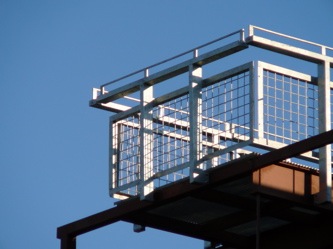
GALVANIZED IRON
© Edwin T. Freedley, Philadelphia and its Manufactures (1867), pp. 402 & 407.
The principal restriction hitherto to the more extended use of Iron has been its tendency to oxydation or rust, but happily mechanical ingenuity has overcome this difficulty. Iron is now coated with another metal, forming a combination impervious to atmospherical influences, and known as Galvanized Iron.
The process of effecting this great change in this useful material, and forming Galvanized Sheet Iron, is described to us by a leading firm in the business, as follows: The Iron is first rolled into sheets as ordinary Sheet Iron; but for the purpose of galvanizing, a selection is necessary, for experience has proved that Iron, though of good quality, will not in all cases combine with the zinc which is used in coating. The sheets selected are rolled very smooth and well trimmed to the size required, and cleansed from all impurities by a weak acid. The effects of the acid are in turn removed by immersion in a tank of clear water, and then the sheets are dried in an oven. The iron thus prepared is placed in contact with the zinc, and, the two metals being brought to the same temperature, combine and fuse, and form a material impervious to rust, and requiring neither paint nor any preservative agent. The proper regulation of the temperature of the zinc and the iron is a point of great nicety, requiring in the manufacturer much previous experience.
The firm to whom this material is indebted for much of its present popularity and even intrinsic value, and who, we understand, were the first to introduce the manufacture of Galvanized Sheet Iron, are Messrs. McCullough & Co., now succeeded by the MCCULLOUGH IRON COMPANY of Philadelphia. Their Works include five Rolling Mills in Maryland, besides the Galvanizing Works at the corner of Eleventh and Washington avenue, in Philadelphia, and are believed to be the most extensive of the kind in the Union. For a history and description of them, see MCCULLOUGH IRON COMPANY [below].
The Galvanized Iron of this firm has been tested by the eminent chemist of the Mint, Professor Booth, who pronounced it equal to that of English manufacture; and in certain tests by sulpburic and other acids, it proved superior. Its applications are necessarily almost as numerous as Iron itself, being available wherever exposed to corrosive influences, and specially adapted for Roofing, Iron-work for Ships, Water and Gas Tubing, Window Shutters, Telegraph Wire, etc.
THE MCCULLOUGH IRON COMPANY's WORKS
© Edwin T. Freedley, Philadelphia and its Manufactures (1867), p. 598-600.
... Their Galvanizing Works, as well as their Office and Warehouse, are located in Philadelphia, where the principal business of the COMPANY is transacted. They were the first to introduce the manufacture of Galvanized Sheet Iron, Hoop Iron, Galvanized Water Pipes, etc., etc., in the United States, having in 1852 obtained skilled workmen from England for the purpose. The manufacture of these is now a very important branch of their business, and has become an important and constantly augmenting branch of the business of the country. The Galvanized Sheet Iron of the MCCULLOUGH IRON COMPANY has a wide reputation by reason of their enlarged experience and the particular attention which they have bestowed upon this specialty of their business, and is said to be superior to any other, either of domestic or foreign manufacture.
Among other advantages this Company possesses, is the exclusive right of Mr. E. A. HARVEY'S valuable Patent for cleaning iron and other metals from dust, dirt or oxide, which must in time become invaluable.
The black dust from the bituminous coal used in the process of manufacturing, has heretofore remained on the sheet when finished, and was always objectionable to the workers in this article. By this patent process the sheet passes through a cleaning machine of Mr. HARVEY'S invention (consuming but a moment) when it comes out as free from dust and dirt as a sheet of the finest paper. This is a great desideratum with the worker, and must in time altogether supersede the old method of manufacture.
pages 598-600
PHILADELPHIA AND ITS MANUFACTURES; A HAND-BOOK OF THE GREAT MANUFACTORIES AND REPRESENTATIVE MERCANTILE HOUSES OF PHILADELPHIA, IN 1867.
author: Edwin T. Freedley
publisher: Edward Young & Co, Philadelphia